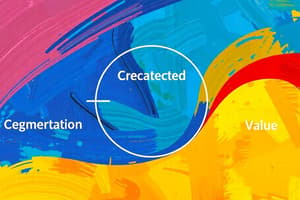Podcast
Questions and Answers
What is meant by maximizing customer perceived value?
What is meant by maximizing customer perceived value?
- Highlighting the unique personalities of trainers
- Ensuring customers receive the greatest benefits for minimal costs (correct)
- Focusing solely on customer experience
- Offering Peloton equipment and service at a low cost
What is the Resonance-Focus Model?
What is the Resonance-Focus Model?
Peloton's strategy to highlight the personalities of their elite trainers based on deep understanding of customer needs.
What does creating the demand landscape involve?
What does creating the demand landscape involve?
Tracking customer behaviors to group them into categories of goals, activities, and priorities.
What is a touch point in the context of Peloton?
What is a touch point in the context of Peloton?
What is customer relationship management?
What is customer relationship management?
What is selective relationship management?
What is selective relationship management?
Peloton uses net promoter scores to measure customer satisfaction.
Peloton uses net promoter scores to measure customer satisfaction.
What does creating a customer-centric culture involve at Peloton?
What does creating a customer-centric culture involve at Peloton?
What mistake did Peloton acknowledge regarding customer loyalty?
What mistake did Peloton acknowledge regarding customer loyalty?
How does Peloton plan brand extensions?
How does Peloton plan brand extensions?
Flashcards are hidden until you start studying
Study Notes
Maximizing Customer Perceived Value
- Peloton prioritizes delivering high total benefits while minimizing costs for key customers despite its high pricing.
Resonance-Focus Model
- The company leverages a deep understanding of customer motivations, showcasing the distinct personalities of elite trainers as a competitive advantage.
Creating the Demand Landscape
- Peloton conducts extensive tracking of customer behaviors through various methods, including observations and journals, to categorize distinct goals and priorities.
Touch Point
- Key customer interaction occurs during the purchase and registration process, highlighting an essential connection between the brand and consumers.
Customer Relationship Management
- Detailed customer data collected at touch points informs Peloton's development of tailored product offerings, services, and communications.
Selective Relationship Management
- Peloton analyzes customer information for profitability, allowing for a focus on fewer, more profitable customer segments over time.
Net Promoter Score
- The company measures customer satisfaction through a survey asking about the likelihood of recommending Peloton to others after product use.
Creating a Customer-Centric Culture
- Peloton invests in a rigorous recruitment and training process for trainers to enhance customer experience, ensuring trainers are multifaceted entertainers and coaches.
Creating False Loyalty, rather than True Loyalty
- Peloton acknowledges the mistake of using cancellation fees to gauge loyalty, recognizing that it fostered a false sense of commitment among customers.
Plan Brand Extensions Based on Customer Needs, not Component Similarities
- Instead of just developing new exercise machines, Peloton focuses on expanding into non-machine-based exercises like Yoga, guided by customer needs and preferences.
Studying That Suits You
Use AI to generate personalized quizzes and flashcards to suit your learning preferences.




